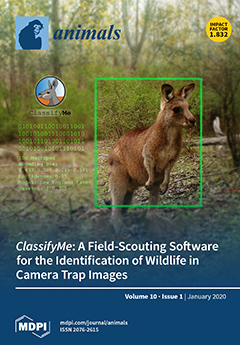Previous studies have indicated that cattle with more excitable temperaments exhibit an increased stress response. The objective of this study was to investigate the relationship between temperament traits, handling, and stress-induced hyperthermia (SIH) in beef cattle. Rectal temperatures (T
REC, °C) of 60 purebred Angus cattle (30 heifers, 30 steers; 235.2 ± 5.11 kg) were recorded at 20 s intervals from 30 min prior to handling until two hours post handling. All cattle were exposed to a standardized handling procedure consisting of (i) being restrained in a weighing box for 30 s; (ii) being held within the crush for 30 s; and then (iii) being restrained in a head bail for 60 s. Cattle temperaments were evaluated via three traits: (1) agitometer score (AG); (2) crush score (CS); and (3) flight speed (FS) during the handling procedure. Agitometer scores and FS measures were used to describe an AG category (AG
CAT) and an FS category (FS
CAT) that were used to classify animals into three temperament categories: 1, calm; 2, intermediate; and 3, temperamental. Pearson’s correlation coefficients were used to evaluate the associations between (i) AG, CS, FS, and T
REC 30 min prior to entry into the weighing box (T-30) and then at 1 min intervals between time of entry into the weighing box (T0) until 10 min post-weighing (T10); and (ii) the relationship between AG, CS, and FS. The relationship between T
REC and temperament traits over the 2.5 h were modeled by using a first-order autoregressive repeated measures model. Flight speed had strong to moderate associations with T
REC at T-30 (r ≥ 0.37;
p ≤ 0.006) and between T0 and T10 (r ≥ 0.36;
p ≤ 0.01). There were moderate associations amongst T
REC between T0 and T10 and CS (r ≥ 0.31;
p ≤ 0.01). A weak relationship existed with CS (r = 0.16;
p = 0.16). There were no associations between AG and T
REC at T-30 (r ≥ −0.15;
p = 0.84) or between T0 and T10 (r ≤ 0.04;
p ≥ 0.4). Rectal temperature, irrespective of sex and temperament traits, was influenced by time (
p < 0.0001), and maximum T
REC (39.3 ± 0.04 °C) occurred between 4 and 5.7 min after entry into the weighing box. In addition, CS (
p = 0.007) influenced T
REC in these cattle. There were also time × temperament trait × sex interactions with the CS (
p = 0.0003) and FS
CAT (
p = 0.043) categories; however, time × temperament trait interactions were not statistically significant. Results from this study suggest that cattle with excitable temperaments, as evaluated by FS and CS, have a greater increase in T
REC. In addition, these results suggest that a relationship exists between basal T
REC and FS and CS. Together, these results highlight that temperament, as assessed by FS and CS, influences both basal T
REC and the peak temperature recorded following handling but does not influence the magnitude of change in T
REC post handling.
Full article






